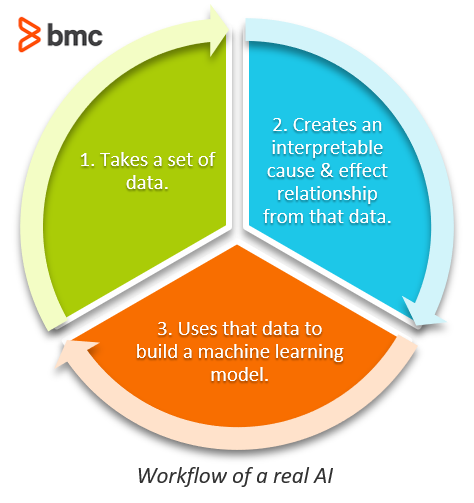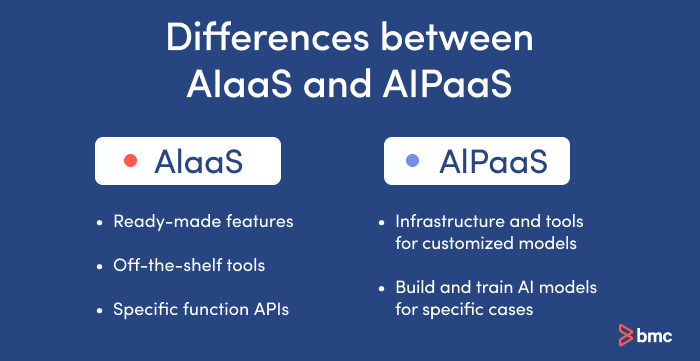Today, almost all companies are using at least one type of as a service offerings as a way to focus on their core business and outsource other needs to third-party experts and vendors. Though software as a service has the largest global spend —$105 million spent in 2020 alone—IaaS and PaaS are expected to grow faster in the coming years.
Now the same as a service approach is being applied to a new field: AIaaS. AIaaS is short for Artificial Intelligence-as-a-service. The term and the product are on the rise, and we’re digging into what AIaaS means in this article.
We’ll look at:
- What is AIaaS?
- Understanding AI
- The growth of AIaaS
- AIaaS types
- Benefits & drawbacks
- Common vendors
- AIaaS vs. AIPaaS
- Additional resources
Let’s get started.
What is AIaaS?
AIaaS stands for artificial intelligence as a service. It refers to off-the-shelf AI tools that enable companies to implement and scale AI techniques at a fraction of the cost of a full, in-house AI.
The concept of everything as a service refers to any software that can be called upon across a network because it relies on cloud computing. In most cases, the software is available off the shelf. You buy it from a third-party vendor, make a few tweaks, and begin using it nearly immediately, even if it hasn’t been totally customized to your system.
For a long time, artificial intelligence was cost-prohibitive to most companies:
- The machines were massive and expensive.
- The programmers who worked on such machines were in short supply (which meant they demanded high payments).
- Many companies didn’t have sufficient data to study.
As cloud services have become incredibly accessible, AI is more accessible: companies can gather and store infinite data. This is where AI-as-a-service comes in.
Now, let’s detour into AI so that we have the right expectations when engaging with AIaaS.
Understanding AI
We hear it repeated over and over: artificial intelligence is a way to get machines to do the same kind of work that human brains can accomplish. This definition is the subject of significant debate, with technology experts arguing that comparing machines to human brains is the wrong paradigm to use. It may promote fear that humans can be taken over by machines.
The term AI can also be used as a marketing tactic for companies to show how innovative they are—something known as artificial AI or fake AI.
Before we start worrying about the technological singularity, we need to understand what AI actually is.
“Intelligence is the efficiency with which you acquire new skills at tasks you didn’t previously prepare for… Intelligence is not skill itself, it’s not what you can do, it’s how well and how efficiently you can learn new things.” — Francois Challot, AI Researcher at Google and creator of Keras
Machines that can adapt to new environments and create solutions to new problems are said to exhibit artificial intelligence. Just like humans are constantly reacting to new challenges, computers are now able to react in ways which their programmers didn’t explicitly program them for.
Importantly, though, AI isn’t created on its own—humans create it. We call some entity intelligent if it can do things humans normally do.
Today, machine learning is the leading type of AI. It’s the most mature of several areas of AI. Just like AI, though, there’s a lot of hype around ML versus what it actually is. Today, ML can do a lot of things, but it isn’t some pie in the sky solution that will solve all your organizational problems.
(Understand the differences in ML and AI.)
How does AI work?
The majority of AI makes use of algorithms. Algorithms are defined as a set of rules or a process that is followed, typically by a computer, to calculate or solve a problem. For AI algorithms, computers solve specific tasks by:
- Studying very large amounts of data.
- Making generalizations or statistical estimations.

AI algorithms are often broken into two types:
- Machine learning algorithms, including classification and regression
- Deep learning algorithms that employ deep neural nets
(Explore top ML algorithms.)
When these algorithms are applied in certain ways, computers can seem to act like a human brain:
- Determining objects in a picture
- Carrying on a spontaneous conversation with a human being
- Responding to roadblocks from a driverless car
- Chatting with humans with 24/7 availability
Companies want to take advantage of all the insight they can glean from data. For organizations, data might help them:
- Better understand their customers and what they want
- Find points in production and service delivery that can be automation
- Understand why some people buy and some don’t
Any seemingly intangible information can turn out to be the competitive edge.
(Compare three simple data strategies and data ethics for businesses.)
AI is big business
If your company isn’t employing artificial intelligence yet, you will be soon. International Data Corporation (IDC) estimates that worldwide spending on AI will increase from the $50.1 billion spent in 2020 to more than $110 billion by 2024.
A farther look back shows that only $12 billion was spent in 2017. That means global spending is expected to have increased almost tenfold in only seven years.
It seems that all this spending is coming from many places—not just the big enterprises. Flexera recently reported on the wide-scale adoption of AI:
- 28% of enterprises are experimenting with AI/ML.
- 46% of enterprises are experimenting or plan to experiment with AI/ML.
- AI/ML is the field companies are most experimenting in.
What does this mean? Surely that AI and ML are on most organizational radars today. The bigger takeaway might be that almost half of all enterprises are expected to be using the technology in the next few years.
The growth of AIaaS
For companies that can’t or are unwilling to build their own clouds and build, test, and utilize their own artificial intelligence systems, artificial intelligence as a service is the solution. This is the biggest draw: the opportunity to take advantage of data insights without needing the massive up-front investment in talent and resources.
Like other “as a service” options, the same benefits apply with AIaaS:
- Staying focused on core business (not becoming data and machine learning experts)
- Minimizing the risk of investment
- Increasing the benefits you gain from your data
- Improving strategic flexibility
- Making cost flexible and transparent
Types of AIaaS
Common types of AIaaS include:
Chatbots & digital assistance
These can include chatbots that use natural language processing (NLP) algorithms to learn from conversations with human beings and imitate the language patterns while providing answers. This frees up customer service employees to focus on more complicated tasks.
These are the most widely used types of AIaaS today.
Cognitive computing APIs
Short for application programming interface, APIs are a way for services to communicate with each other. APIs allow developers to add a specific technology or service into the application they are building without writing the code from scratch. Common options for APIs include:
- NLP
- Computer speech and computer vision
- Translation
- Knowledge mapping
- Search
- Emotion detection
Machine learning frameworks
ML and AI frameworks are tools that developers can use to build their own model that learns over time from existing company data.
Machine learning is often associated with big data but can have other uses—and these frameworks provide a way to build in machine learning tasks without needing the big data environment.
Fully managed machine learning services
AI machine learning frameworks are the first step towards machine learning. This option is a way to add in richer machine learning capabilities using templates, pre-built models, and drag-and-drop tools to assist developers in building a more customized machine learning framework.

Benefits & drawbacks of AIaaS
Like any other “as a service” offering, the AI as a service business model brings value to companies without costing huge amounts. However, there are also distinct drawbacks to using a cloud-based AI system that no business should ignore.
Why should I use AIaaS?
- Advanced infrastructure at a fraction of the cost. Successful AI and machine learning requires many parallel machines and speedy GPUs. Prior to AIaaS, a company may decide the initial investment and ongoing upkeep too much. Now, AI infrastructure as a service means companies can harness the power of machine learning at significantly lower costs. This means you can continue working on your core business, not training and spending on areas that only partially support decision-making.
- Flexibility. Hand in hand with lower costs, there’s a lot of transparency within AIaaS: pay for what you use. Though machine learning requires a lot of compute power to run, you may only need that power in short amounts of time—you don’t have to be running AI non-stop.
- Usability. While many AI options are open source, they aren’t always user-friendly. This means your developers are spending time installing and developing the ML technology. Instead, AIaaS is ready out of the box—so you can harness the power of AI without becoming technical experts first.
- Scalability.Artificial intelligence as a service allows you to start with smaller projects to learn if it fits your needs correctly. As you gain experience with your own data, you can tweak your service and scale up or down as project demands change.
What are the challenges of AIaaS?
- Reduced security. AI and machine learning depend on significant amounts of data, which means your company must share that data with third-party vendors. Data storage, access, and transit to servers must be secured to ensure the data isn’t improperly accessed, shared, or tampered with.
- Reliance. Because you’re working with one or more third parties, you’re relying on them to provide the information you need. This isn’t inherently a problem, but it can lead to lag time or other issues if any problems arise.
- Reduced transparency. In AIaaS, you’re buying the service, but not the access. Some consider as a service offerings, particularly those in ML, like a black box —you know the input and the output, but you don’t understand the inner workings, like which algorithms are being used, whether the algorithms are updated, and which versions apply to which data. This may lead to confusion or miscommunication regarding the stability of your data or the output.
- Data governance. Particular industries may limit whether or how data can be stored in a cloud, which altogether may prohibit your company from taking advantage of certain types of AIaaS.
- Long-term costs. Costs can quickly spiral with all “as a service” offerings and AIaaS is no exception. As you wade deeper into AI and machine learning, you may be seeking out more complex offerings, which can cost more and require that you hire and train staff with more specific experience. As with anything, though, the costs may be a wise investment for your company.
Vendors of AIaaS
You can probably guess the major vendors of AIaaS.
AI as a service examples include Amazon Web Services (AWS), Microsoft Azure, and Google Cloud Platform (GCP), which are all industry-leading companies that have brought AIaaS offerings to many companies worldwide. Each vendor offers different types of bots, APIs, and machine learning frameworks, in addition to fully managed machine learning options.
Other AI as a service examples feature well-known technology firms, including Salesforce, Oracle, and SAP, moving into the Big 3’s territory.
Countless start-ups that are focusing on various parts of AIaaS, as well. As in all industries, it’s not uncommon for the larger companies to purchase the smaller companies to add the developed services to their portfolios.
Difference between AI as a service (AIaaS) and AI platform as a service (AIPaaS)
Cloud-based offerings make technology advances more accessible, affordable, and scalable–while helping businesses stay current with the latest innovations. These benefits are especially valuable for AI technologies–hence the rapid growth of AIaaS and AIPaaS.
The differences between AIaaS and AIPaaS revolve around their scope and purpose. AIaaS offers ready-made, off-the-shelf tools and APIs that address specific functions and needs. That approach is not adequate when you require customized models. AIPaaS provides the infrastructure and tools to build and train AI models that address a specific use case.
AI platform as a service (AIPaaS)
AIPaas is a specialized IaaS that provides a full AI solution development environment. Data scientists and advanced developers have the flexibility they need to manage data and then create and train AI models tailored to organizational needs. AIPaaS also offers infrastructure and tools for deploying and managing models.
Key differences

Future of AIaaS
As a rapidly growing field, AIaaS has plenty of benefits that bring early-adapters to the table. But, its drawbacks mean there’s plenty of room for improvement.
While there may be bumps in the road while developing AIaaS, it’s likely to be as important than other “as a service” offerings. Taking these valuable services out of the hands of the few means that many more organizations can harness the power of AI and ML.
Related reading
- BMC Machine Learning & Big Data Blog
- The State of AI Today
- Mindful AI
- What Is AIOps?
- 4 Types of Artificial Intelligence
- Machine Learning as a Service (MLaaS) Explained
These postings are my own and do not necessarily represent BMC's position, strategies, or opinion.
See an error or have a suggestion? Please let us know by emailing blogs@bmc.com.






